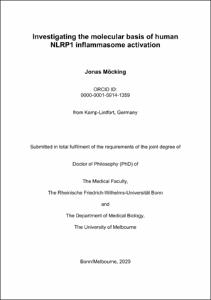Investigating the molecular basis of human NLRP1 inflammasome activation

Investigating the molecular basis of human NLRP1 inflammasome activation

| dc.contributor.advisor | Geyer, Matthias | |
| dc.contributor.author | Möcking, Jonas | |
| dc.date.accessioned | 2020-04-27T20:52:09Z | |
| dc.date.available | 2020-04-27T20:52:09Z | |
| dc.date.issued | 10.03.2020 | |
| dc.identifier.uri | https://hdl.handle.net/20.500.11811/8333 | |
| dc.description.abstract | Cytosolic sensor proteins like NLRP1 (NOD-like receptor containing a pyrin domain 1) play a fundamental role in mediating innate immunity. Upon activation they form signalling hubs that recruit the adaptor protein ASC (apoptosisassociated speck-like protein containing a CARD) and procaspase-1 to form an inflammasome. Procaspase-1 is in turn activated and processes the cytokines pro-IL-1β and pro-IL-18 as well as the pore-forming protein GSDMD (Gasdermin D) into their mature forms, resulting in inflammation and pyroptosis. When dysregulated, inflammasomes are often involved in the development of autoinflammatory diseases. Therefore, it is of major interest to understand the molecular mechanisms underlying the regulation of inflammasome sensors. A biochemical approach was taken to investigate the structural basis of inflammasome formation. Producing and characterizing recombinant protein of separate domains of NLRP1 demonstrated that NLRP1 autoinhibition is not mediated by direct intramolecular interaction of the N-terminal PYD with other domains. Additionally, the full-length NLRP1 protein was characterized by biochemical and structural means. Size exclusion chromatography indicated that recombinant NLRP1 forms oligomers in solution. Small-angle X-ray scattering confirmed this observation and further allowed the calculation of a molecular envelope of the NLRP1 oligomer. The oligomeric state of the protein was estimated to be hexameric, based on the particle volume derived from the molecular envelope. Furthermore, a highly sensitive reversed-phase HPLC assay was employed to measure the ATP hydrolysis activity of recombinant full-length NLRP1. In contrast to previous reports, we found that NLRP1 hydrolyses ATP at a low rate. The physiological relevance of this activity was investigated by taking a mutational approach in functional assays in cells measuring inflammasome activation. Substitution of residues identified by computational analysis of the nucleotide binding site suggested that ATP hydrolysis is involved in maintaining NLRP1 in an autoinhibited state. A similar approach was taken to investigate the involvement of direct modifications of the NLRP1 protein in regulating inflammasome activity. Functional effects of a single nucleotide polymorphism, which leads to the amino acid substitution M1184V in the NLRP1 protein and is described to increase autoproteolysis in the NLRP1 FIIND domain, were investigated. The results showed that increased cleavage can amplify or inhibited activation of NLRP1 in the context of different stimuli. Moreover, a potential phosphorylation within the CARD domain was identified as another essential modification regulating the activity of NLRP1. Overall, this work provides new insights into the role of structural mechanisms, ATP as a cofactor and posttranslational modifications in regulating NLRP1 inflammasome activity. | |
| dc.language.iso | eng | |
| dc.rights | In Copyright | |
| dc.rights.uri | http://rightsstatements.org/vocab/InC/1.0/ | |
| dc.subject | Inflammation | |
| dc.subject | Inflammasom | |
| dc.subject | NLRP1 | |
| dc.subject | Inflammasome | |
| dc.subject.ddc | 570 Biowissenschaften, Biologie | |
| dc.subject.ddc | 600 Technik | |
| dc.title | Investigating the molecular basis of human NLRP1 inflammasome activation | |
| dc.type | Dissertation oder Habilitation | |
| dc.publisher.name | Universitäts- und Landesbibliothek Bonn | |
| dc.publisher.location | Bonn | |
| dc.rights.accessRights | openAccess | |
| dc.identifier.urn | https://nbn-resolving.org/urn:nbn:de:hbz:5-57831 | |
| ulbbn.pubtype | Erstveröffentlichung | |
| ulbbnediss.affiliation.name | Rheinische Friedrich-Wilhelms-Universität Bonn | |
| ulbbnediss.affiliation.location | Bonn | |
| ulbbnediss.affiliation.otherLocation1 | Melbourne | |
| ulbbnediss.affiliation.otherName1 | University of Melbourne | |
| ulbbnediss.thesis.level | Dissertation | |
| ulbbnediss.dissID | 5783 | |
| ulbbnediss.date.accepted | 09.01.2020 | |
| ulbbnediss.institute | Medizinische Fakultät / Institute : Institut für Strukturbiologie | |
| ulbbnediss.fakultaet | Medizinische Fakultät | |
| dc.contributor.coReferee | Masters, Seth | |
| ulbbnediss.contributor.orcid | https://orcid.org/0000-0001-5914-1359 |
Dateien zu dieser Ressource
Das Dokument erscheint in:
-
E-Dissertationen (1588)




